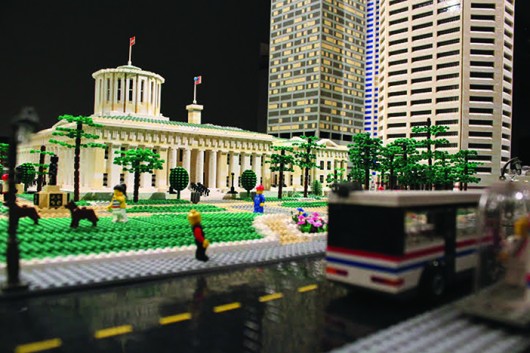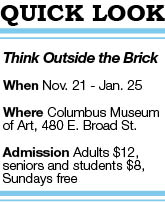
Members of the Central Ohio Lego Train Club built a replica of the Ohio Statehouse in downtown Columbus with Legos.
Credit: Courtesy of Nancy Colvin and Jeff Sims
Columbus wasn’t built in a day. In fact, it took one group of avid builders nine years to assemble.
An exhibit featuring sculptures made entirely from Legos — “Think Outside the Brick” — is making its third annual appearance at the Columbus Museum of Art’s Center for Creativity starting Friday.
The exhibition will explore the city of Columbus through Legos that come in many colors, sizes and shapes.
The main installation is built by the Central Ohio Lego Train Club — a group of Ohio-dwelling adults who see the colorful bricks not as a children’s toy, but as an artistic and structural medium.
The COLTC’s collaborative model, “Columbus: Real and Imagined,” has consistently been the show’s main feature since its first appearance in 2012 — nine years after the COLTC first started working on it. The piece routinely undergoes design changes and has some fresh, original elements this year, said Jeff Sims, creative producer for the Columbus Museum of Art’s Center for Creativity.

Click to enlarge.
“They’ve come up with a pretty interesting idea this year, where there’s going to be a range of time periods represented,” Sims said. “Visitors will see familiar landmarks, like the Huntington building or the Statehouse, but there are also things that COLTC members have imagined or things they would like to see in Columbus.”
The redesigned model is made up of around 450,000 Lego bricks and spans a 10-by-30-foot floor space. COLTC currently has about 30 members, roughly a third of whom were involved in building this year’s design, said Paul Janssen, one of its builders and president of the COLTC, which was founded by Janssen and several others in 2003.
Janssen, who is also an associate professor of physiology and cell biology at Ohio State’s College of Medicine, said that the constraints a Lego builder is bound to can be a challenge when attempting to make something intricate, such as the COLTC’s configuration of Columbus.
“Lego art is limited by the number of bricks you can get, the color of bricks and the brick sizes,” he said. “The medium doesn’t allow you to make the minute changes that drawing, painting or sculpting does.”
First-year OSU students Nick Armstrong and Christian Moore — both in landscape architecture — agree with Janssen’s sentiment on the art form after making “A Double-Decker Cityscape,” which was chosen to be displayed in the exhibit as part of the CMA’s Lego Design Challenge. Armstrong said it took them about 10 hours total to finish.
“You’re a lot more limited in resources,” Armstrong said about building with Legos. “So you have to think a little more outside-the-box when designing shapes, buildings and other things that wouldn’t naturally be made of rectangular bricks.”
The contest asked applicants — who could work individually or in a team, group or family — to explore what “building, structure or mode of transportation a new Columbus needs,” and to draw inspiration from “The Lego Movie,” said Kelsey Cyr, visitor engagement coordinator at the CMA.
The 17 finalists were selected out of 75 applicants by a panel of four local creative professionals — one of whom was Janssen — and each model will be laid out alongside one another to create one big cityscape, Cyr said.
“The idea of our project was to combine Columbus with more plants and natural elements, so we have things like a canyon and a waterfall that runs in between buildings and over shops,” Armstrong said. “It would give people the chance to experience nature more often, and still have the same type of thing that you would want to do in the city.”
Three additional OSU architecture students are also finalists in the design challenge for their model “Columbus Buckeye Museum,” Cyr said.
Janssen said the COLTC’s current configuration has three parts: one depicting Columbus with various close replicas of structures such as The Columbus Dispatch headquarters and the old railway station, a second portraying a rural area that’s not necessarily supposed to be Columbus and lastly, a medieval town with fantasy buildings.
The model will also have about 20 miniature car2gos to “keep up with the times,” he said.
Janssen is also known for the 8-by-6-foot Ohio Stadium replica he made from one million Lego pieces, which he completed in 2011.
“I don’t like to do dull or simple things; I try to do more complicated structures,” he said. “Building the stadium was the most challenging, and, therefore, fun, piece I’ve completed.”
It took him two years to complete, after which it was displayed in the CMA’s first “Think Outside the Brick” exhibit. It’s now in two different parts in a storage locker, he said.
“I’ve had a couple of offers but time wise, it hasn’t worked out,” Janssen said. “But now, I’d probably be ready to put it up somewhere, preferably on campus.”
Visitors can vote on their favorite model from the Lego Design Challenge, and the top four will be announced at the CMA on New Year’s Day. Each grand prize winner receives a $200 Amazon gift card. The exhibit is set to run through Jan. 25.
“The purpose of the show is to promote creative thinking for everybody,” Sims said. “Lego can be used as a vehicle for exploration of new ideas and innovation.”


